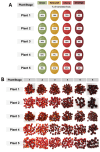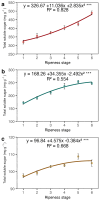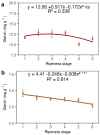Variation in Soluble Sugars in Arabica Coffee Cherry Fruits
- PMID: 38999694
- PMCID: PMC11243843
- DOI: 10.3390/plants13131853
Variation in Soluble Sugars in Arabica Coffee Cherry Fruits
Abstract
The maturation of Arabica coffee fruits is influenced by both endogenous and external factors. The stage of fruit maturation affects the chemical composition of the beans, which in turn impacts the quality of the coffee beverage. During maturation, the fruit peel changes colour from green to red (cherry), signalling the optimal harvest time and suggesting high fruit quality. However, the degree of redness can vary, indicating different levels of maturity. This study aimed to explore the variation in soluble sugar accumulation in relation to the redness of coffee fruit tissues. We classified ripe fruits into six ripeness categories based on the intensity of the red colour of the epicarp, measured using a colourimeter. We analysed total soluble sugar, sucrose, and starch in three parts: coat (exocarp + mesocarp), coat juice (obtained by squeezing the coat), and beans. Our findings reveal that the variation in sugar in the endosperm does not correspond to changes in the coat, suggesting separate regulation of sugar accumulation, particularly sucrose, which is crucial for coffee quality. Our data indicate that there is no transfer of sucrose and reducing sugars from the red coat to the bean.
Keywords: Coffea arabica; coffee quality; sucrose.
Conflict of interest statement
The authors declare no conflicts of interest.
Figures






References
-
- Leroy T., Ribeyre F., Bertrand B., Charmetant P., Dufour M., Montagnon C., Marraccini P., Pot D. Genetics of Coffee Quality. Braz. J. Plant Physiol. 2006;18:229–242. doi: 10.1590/S1677-04202006000100016. - DOI
-
- Vaast P., Bertrand B., Perriot J.J., Guyot B., Génard M. Fruit Thinning and Shade Improve Bean Characteristics and Beverage Quality of Coffee (Coffea arabica L.) under Optimal Conditions. J. Sci. Food Agric. 2006;86:197–204. doi: 10.1002/jsfa.2338. - DOI
-
- Ribeiro D.E., Borem F.M., Cirillo M.A., Vilela M.B.P., Ferraz V.P., Alves H.M.R., Taveira J.H.d.S. Interaction of Genotype, Environment and Processing in the Chemical Composition Expression and Sensorial Quality of Arabica Coffee. Afr. J. Agric. Res. 2016;11:2412–2422. doi: 10.5897/AJAR2016.10832. - DOI
-
- Mazzafera P. Chemical Composition of Defective Coffee Beans. Food Chem. 1999;64:547–554. doi: 10.1016/S0308-8146(98)00167-8. - DOI
-
- Osorio Pérez V., Matallana Pérez L.G., Fernandez-Alduenda M.R., Alvarez Barreto C.I., Gallego Agudelo C.P., Montoya Restrepo E.C. Chemical Composition and Sensory Quality of Coffee Fruits at Different Stages of Maturity. Agronomy. 2023;13:341. doi: 10.3390/agronomy13020341. - DOI
LinkOut - more resources
Full Text Sources

